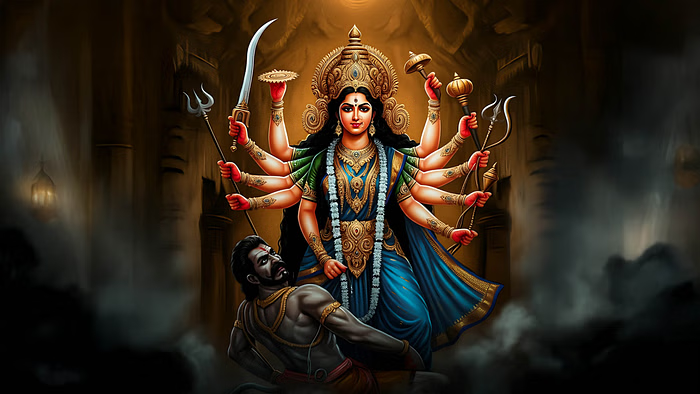
Shardiya Navratri, the nine-day festival dedicated to the worship of Goddess Durga and her various forms, is an event deeply embedded in Hindu spirituality and Indian cultural tradition. In 2025, Navratri started with vibrant devotion across the country and will conclude on October 2 with Vijayadashami. Central to Navratri’s spiritual journey are the sacred days of Ashtami (eighth day) and Navami (ninth day), when devotees not only intensify their prayers but also perform the revered ritual of Kanya Pujan. This article explores the dates, significance, traditions, and correct timing (muhurat) for Kanya Pujan in Shardiya Navratri 2025.
The Importance of Ashtami and Navami in Navratri
Navratri is devoted to nine forms of Goddess Durga, each day honoring one divine facet of Shakti. While every day carries its own spiritual value, Ashtami and Navami (this year falling at the end of September and start of October) hold special significance:
- Maha Ashtami: Celebrated as a day of intense worship, this is when the power of the goddess is believed to be at its zenith. It is on Ashtami that Durga is worshipped in her fierce form, Mahagauri or Mahishasuramardini, the slayer of the demon Mahishasura.
- Maha Navami: Considered equally auspicious, the ninth day is often marked by Maha Aarti and the offering of special bhog (sacred food) to the goddess, culminating the main rituals before Vijayadashami.
On both these days, a unique aspect of devotion unfolds—Kanya Pujan, the worship of young girls symbolizing the nine forms of Durga.
Dates for Ashtami and Navami in 2025
In 2025, Shardiya Navratri will come to its powerful crescendo as follows:
- Maha Ashtami: Tuesday, September 30, 2025
- Maha Navami: Wednesday, October 1, 2025
These dates are particularly emphasized in Hindu households and community puja pandals across India, with elaborate arrangements for worship and celebrations.
Kanya Pujan: The Ritual and Its Meaning
Kanya Pujan, also called Kuwari Puja, is one of the most poignant rituals in Navratri. Rooted in the belief that every girl embodies a living form of the Goddess herself, Kanya Pujan is a ritual that bridges divine worship with social respect for little girls—usually between the ages of 2 and 10.
How is Kanya Pujan Performed?
- Preparation: Homes or temples are meticulously cleaned. Altars are decorated with flowers, rangoli, and lamps.
- Inviting the Girls: Family members invite young girls (ideally nine, but any number is accepted) to the home or pandal on Ashtami, Navami, or sometimes both days.
- Washing Feet: As a sign of utmost reverence, the host washes the feet of the girls—believed to purify the space and invoke the goddess’s blessings.
- Tika and Aarti: The girls are welcomed with tilak (vermilion mark) and offered aarti (ritual waving of lamp).
- Special Meal: Kanya are served a traditional meal—usually puri (fried bread), chana (chickpeas), halwa (sweet), and fruits.
- Gifts: Finally, the girls are gifted clothes, bangles, and small tokens according to capacity, and their blessings are respectfully sought.
Even a single girl child can be worshipped if more aren’t available—the act itself is symbolic and deeply transformative at a spiritual level.
The Spiritual and Social Message
Kanya Pujan is not only a spiritual observance but also a profound cultural affirmation. It upholds the dignity and value of girls in the family and society, reminding all that the feminine is the primal force of creation and strength. It encourages gratitude, humility, compassion, and the fostering of equality.
From a esoteric perspective, worshipping the “living goddess” brings peace, health, prosperity and spiritual protection to the household. In many communities, widows and unmarried women are also honored as carriers of the Divine Feminine during Navratri.
Auspicious Timing (Muhurat) for Kanya Pujan 2025
The exact muhurat—auspicious time—for Kanya Pujan varies each year and depends on community tradition and family priest’s advice. However, the eight and ninth days of Navratri, especially the morning hours before noon, are considered most auspicious for this beautiful rite. Many prefer to perform Kanya Pujan immediately after the main puja, with the distribution of Navratri prasad.
Social Celebrations and Community Bonding
Beyond personal households, Kanya Pujan is celebrated on a larger scale in temples, community centers, and public pandals. Local committees, religious organizations, and neighborhoods organize grand Kanya Bhoj, inviting hundreds of girls and reinforcing the message of community harmony and inclusive worship.
Schools and NGOs also participate, organizing awareness programs on girl child empowerment, education, and well-being during Navratri.
Other Practices on Ashtami and Navami
- Havan/Homam: On Navami, Yagna or homa (fire oblation) is performed with holy chanting, marking the culmination of intense nine-day worship.
- Maha Aarti: Grand aarti ceremonies fill the air with music, mantras, and collective devotion.
- Recitation & Storytelling: The story of Maa Durga’s victory is retold, strengthening faith and transmitting cultural values to children.
- Charity & Service: Many choose these auspicious days for charity, donating food, clothes, or supporting community programs.
Vijayadashami: The Completion
Navratri concludes with Vijayadashami (October 2, 2025)—the victory day when Durga’s triumph over evil is celebrated with processions, immersion of idols, and a renewed pledge to walk the path of dharma and righteousness throughout the year.
Navratri 2025
Shardiya Navratri 2025’s Ashtami and Navami will once again fill homes and hearts across India with faith, color, and the sweet laughter of children honored as embodiments of the Mother Goddess. Kanya Pujan, with its rituals of reverence, underscores the deep connection between devotion and equality, ritual and social change.
May this Navratri, the blessings of Maa Durga through every little goddess—every Kanya—bring strength, peace, and harmony to all.
Wishing everyone a blessed Ashtami, Navami, and a spiritually uplifting Navratri 2025!
